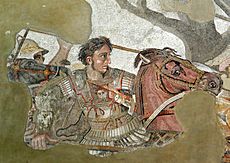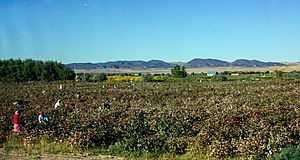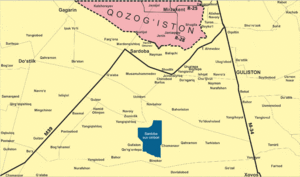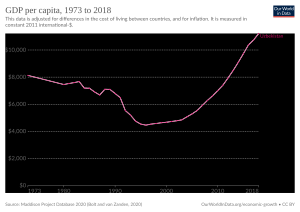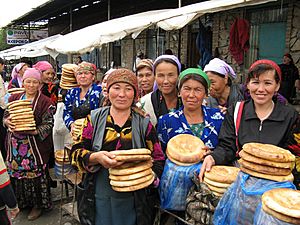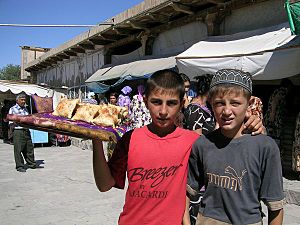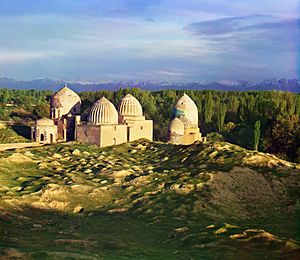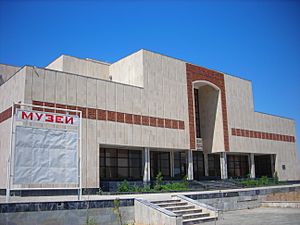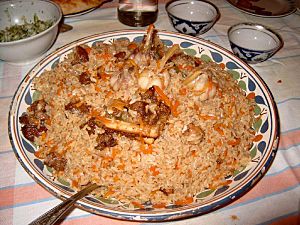Uzbekistan facts for kids
Quick facts for kids
Republic of Uzbekistan
|
|
|---|---|
|
|
|

Location of Uzbekistan (red)
|
|
| Capital and largest city
|
Tashkent 41°19′N 69°16′E / 41.317°N 69.267°E |
| Official languages | Uzbek |
| Recognised regional languages | Karakalpak |
| Spoken languages | Uzbek • Tajik • Karakalpak • Turkmen • Russian • Koryo-mar • Central Asian Arabic • Ukrainian • Azerbaijani • Bukhori • Uyghur • others |
| Ethnic groups
(2021)
|
|
| Religion
(2021)
|
|
| Demonym(s) | Uzbekistani |
| Government | Unitary presidential republic |
|
• President
|
Shavkat Mirziyoyev |
|
• Prime Minister
|
Abdulla Aripov |
| Legislature | Oliy Majlis |
| Senate | |
| Legislative Chamber | |
| Formation | |
|
• Uzbek SSR established after national delimitation
|
27 October 1924 |
|
• Declared independence from the Soviet Union
|
31 August 1991 |
|
• Formally recognised
|
26 December 1991 |
|
• Current constitution
|
8 December 1992 |
| Area | |
|
• Total
|
448,978 km2 (173,351 sq mi) (56th) |
|
• Water (%)
|
4.9 |
| Population | |
|
• 2022 estimate
|
36,024,000 (40th) |
|
• Density
|
74.1/km2 (191.9/sq mi) (128th) |
| GDP (PPP) | 2023 estimate |
|
• Total
|
|
|
• Per capita
|
|
| GDP (nominal) | 2023 estimate |
|
• Total
|
|
|
• Per capita
|
|
| Gini (2013) | ▼ 36.7 medium |
| HDI (2021) | high · 101st |
| Currency | Uzbek sum (UZS) |
| Time zone | UTC+5 (UZT) |
| Date format | dd/mm yyyyc |
| Driving side | right |
| Calling code | +998 |
| ISO 3166 code | UZ |
| Internet TLD | .uz |
|
|
Uzbekistan, officially the Republic of Uzbekistan, is a country located in Central Asia. It is surrounded by five countries: Kazakhstan to the north; Kyrgyzstan to the northeast; Tajikistan to the southeast; Afghanistan to the south; and Turkmenistan to the southwest. Uzbekistan is part of the Turkic world, as well as a member of the Organization of Turkic States. Uzbek is the majority language, while Russian is widely spoken and understood. Islam is the predominant religion, most Uzbeks being Sunni Muslims.
The first recorded settlers in the land of what is modern Uzbekistan were Eastern Iranian nomads, known as Scythians, who founded kingdoms in Khwarazm, Bactria, and Sogdia in the 8th–6th centuries BC, as well as Fergana and Margiana in the 3rd century BC – 6th century AD. The area was incorporated into the Achaemenid Empire and, after a period of Greco-Bactrian rule, was ruled by the Parthian Empire and later by the Sasanian Empire, until the Muslim conquest of Persia in the seventh century. The early Muslim conquests and the subsequent Samanid Empire converted most of the people into adherents of Islam. During this period, cities began to grow rich from the Silk Road, and became a center of the Islamic Golden Age. The local Khwarazmian dynasty was destroyed by the Mongol invasion in the 13th century, leading to a dominance by Turkic peoples. Timur (Tamerlane) in the 14th century established the Timurid Empire. Its capital was Samarkand, which became a centre of science under the rule of Ulugh Beg, giving birth to the Timurid Renaissance. The territories of the Timurid dynasty were conquered by Uzbek Shaybanids in the 16th century. Conquests by Emperor Babur towards the east led to the foundation of the Mughal Empire in India. All of Central Asia was gradually incorporated into the Russian Empire during the 19th century, with Tashkent becoming the political center of Russian Turkestan. In 1924, national delimitation created the Uzbek Soviet Socialist Republic as a republic of the Soviet Union. It declared independence as the Republic of Uzbekistan in 1991.
Contents
Etymology
The name "Uzbegistán" appears in the 16th century Tarikh-i Rashidi.
The origin of the word Uzbek remains disputed.
- "free", "independent" or "own master/leader", requiring an amalgamation of uz (Turkic: "own"), bek ("master" or "leader")
- eponymously named after Oghuz Khagan, also known as Oghuz Beg
- A contraction of Uğuz, earlier Oğuz, that is, Oghuz (tribe), amalgamated with bek "oguz-leader".
All three have the middle syllable/phoneme being cognate with the Turkic title Beg.
History
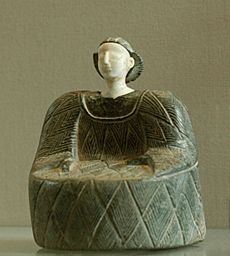
The first people known to have inhabited Central Asia were Scythians who came from the northern grasslands of what is now Uzbekistan, sometime in the first millennium BC; when these nomads settled in the region they built an extensive irrigation system along the rivers. At this time, cities such as Bukhoro (Bukhara) and Samarqand (Samarkand) emerged as centres of government and high culture. By the fifth century BC, the Bactrian, Sogdian, and Tokharian states dominated the region.
As East Asia began to develop its silk trade with the West, using an extensive network of cities and rural settlements in the province of Transoxiana, and further east in what is today Xinjiang, the Sogdian intermediaries became the wealthiest of these merchants. As a result of this trade on what became known as the Silk Route, Bukhara and Samarkand eventually became extremely wealthy cities, and at times Transoxiana (Mawarannahr) was one of the most influential and powerful provinces of antiquity.
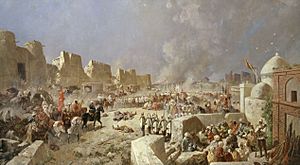
In 327 BC, Macedonian ruler Alexander the Great conquered the Persian Empire provinces of Sogdiana and Bactria, which contained the territories of modern Uzbekistan. Popular resistance to the conquest was fierce, causing Alexander's army to be bogged down in the region that became the northern part of the Macedonian Greco-Bactrian Kingdom. The kingdom was replaced with the Yuezhi-dominated Kushan Empire in the first century BC. For many centuries thereafter the region of Uzbekistan was ruled by the Parthian and Sassanid Empires, as well as by other empires, for example, those formed by the Turkic Gokturk peoples.
The Muslim conquests from the seventh century onward saw the Arabs bring Islam to Uzbekistan. In the same period, Islam began to take root among the nomadic Turkic peoples.
In the eighth century, Transoxiana, the territory between the Amudarya and Syrdarya rivers, was conquered by the Arabs (Qutayba ibn Muslim), becoming a focal point soon after the Islamic Golden Age.
In the ninth and tenth centuries, Transoxiana was brought into the Samanid State. Later, it saw the incursion of the Turkic-ruled Karakhanids, as well as the Seljuks (Sultan Sanjar) and Kara-Khitans.
The Mongol conquest under Genghis Khan during the 13th century brought change to the region. The invasions of Bukhara, Samarkand, Urgench and others resulted in mass murders and unprecedented destruction, which saw parts of Khwarezmia being completely razed.
Following the death of Genghis Khan in 1227, his empire was divided among his four sons and his family members. Despite the potential for serious fragmentation, there was an orderly succession for several generations, and control of most of Transoxiana stayed in the hands of the direct descendants of Chagatai Khan, the second son of Genghis Khan. Orderly succession, prosperity, and internal peace prevailed in the Chaghatai lands, and the Mongol Empire as a whole remained a strong and united kingdom, the Golden Horde.
After the decline of the Golden Horde, Khwarezm was briefly ruled by the Sufi Dynasty until Timur's conquest of it in 1388. Sufids rules Khwarezm as vassals of alternatively Timurids, Golden Horde and the Khanate of Bukhara until Persian occupation in 1510.
In the early 14th century, however, as the empire began to break up into its constituent parts, the Chaghatai territory was disrupted as the princes of various tribal groups competed for influence. One tribal chieftain, Timur (Tamerlane), emerged from these struggles in the 1380s as the dominant force in Transoxiana. Although he was not a descendant of Genghis Khan, Timur became the de facto ruler of Transoxiana and proceeded to conquer all of western Central Asia, Iran, the Caucasus, Mesopotamia, Asia Minor, and the southern steppe region north of the Aral Sea. He also invaded Russia before dying during an invasion of China in 1405. Timur was also known for his extreme brutality and his conquests were accompanied by genocidal massacres in the cities he occupied.
Timur initiated the last flowering of Transoxiana by gathering together numerous artisans and scholars from the vast lands he had conquered into his capital, Samarkand, thus imbuing his empire with a rich Perso-Islamic culture. During his reign and the reigns of his immediate descendants, a wide range of religious and palatial construction masterpieces were undertaken in Samarkand and other population centres. Amir Timur initiated an exchange of medical discoveries and patronised physicians, scientists and artists from the neighbouring regions such as India; His grandson Ulugh Beg was one of the world's first great astronomers. It was during the Timurid dynasty that Turkic, in the form of the Chaghatai dialect, became a literary language in its own right in Transoxiana, although the Timurids were Persianate in culture. The greatest Chaghataid writer, Ali-Shir Nava'i, was active in the city of Herat (now in northwestern Afghanistan) in the second half of the 15th century.
The Timurid state quickly split in half after the death of Timur. The chronic internal fighting of the Timurids attracted the attention of the Uzbek nomadic tribes living to the north of the Aral Sea. In 1501, the Uzbek forces began a wholesale invasion of Transoxiana. The slave trade in the Emirate of Bukhara became prominent and was firmly established at this time. Before the arrival of the Russians, present-day Uzbekistan was divided between the Emirate of Bukhara and the khanates of Khiva and Kokand.
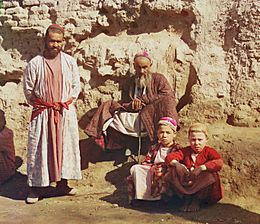
In the 19th century, the Russian Empire began to expand and spread into Central Asia. There were 210,306 Russians living in Uzbekistan in 1912. The "Great Game" period is generally regarded as running from approximately 1813 to the Anglo-Russian Convention of 1907. A second, less intensive phase followed the Bolshevik Revolution of 1917. At the start of the 19th century, there were some 3,200 kilometres (2,000 mi) separating British India and the outlying regions of Tsarist Russia. Much of the land between was unmapped. In the early 1890s, Sven Hedin passed through Uzbekistan, during his first expedition.
By the beginning of 1920, Central Asia was firmly in the hands of Russia and, despite some early resistance to the Bolsheviks, Uzbekistan and the rest of Central Asia became a part of the Soviet Union. On 27 October 1924 the Uzbek Soviet Socialist Republic was created. From 1941 to 1945, during World War II, 1,433,230 people from Uzbekistan fought in the Red Army against Nazi Germany. A number also fought on the German side. As many as 263,005 Uzbek soldiers died in the battlefields of the Eastern Front, and 32,670 went missing in action.
On 20 June 1990, Uzbekistan declared its state sovereignty. On 31 August 1991, Uzbekistan declared independence after the failed coup attempt in Moscow. 1 September was proclaimed National Independence Day. The Soviet Union was dissolved on 26 December of that year. Islam Karimov, previously first secretary of the Communist Party of Uzbekistan since 1989, was elected president of the Uzbek Soviet Socialist Republic in 1990. After the collapse of the Soviet Union in 1991, he was elected president of independent Uzbekistan. An authoritarian ruler, Karimov died in September 2016. He was replaced by his long-time Prime Minister, Shavkat Mirziyoyev, on 14 December of the same year. On 6 November 2021, Mirziyoyev was sworn into his second term in office, after gaining a landslide victory in presidential election.
Geography
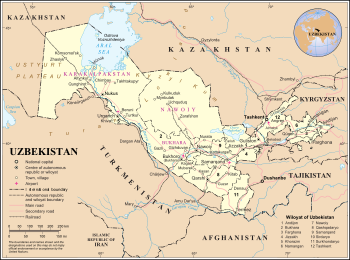
Uzbekistan has an area of 448,978 square kilometres (173,351 sq mi). It is the 56th largest country in the world by area and the 40th by population. Among the CIS countries, it is the fourth largest by area and the second largest by population.
Uzbekistan borders Kazakhstan and the Aralkum Desert (former Aral Sea) to the north and northwest, Turkmenistan and Afghanistan to the southwest, Tajikistan to the southeast, and Kyrgyzstan to the northeast, Uzbekistan is one of the largest Central Asian states and the only Central Asian state to border all the other four. Uzbekistan also shares a short border (less than 150 km or 93 mi) with Afghanistan to the south.
Uzbekistan is a hot, dry, landlocked country. It is one of two doubly landlocked countries in the world (that is, a landlocked country completely surrounded by other landlocked countries), the other being Liechtenstein. In addition, due to its location within a series of endorheic basins, none of its rivers lead to the sea. Less than 10% of its territory is intensively cultivated irrigated land in river valleys and oases, and formerly in the Aral Sea, which has largely desiccated in one of the world's worst environmental disasters. The rest is the vast Kyzylkum Desert and mountains.
The highest point in Uzbekistan is Khazret Sultan at 4,643 metres (15,233 ft) above sea level, in the southern part of the Gissar Range in the Surxondaryo Region on the border with Tajikistan, just northwest of Dushanbe (formerly called Peak of the 22nd Congress of the Communist Party).
The climate in Uzbekistan is continental, with little precipitation expected annually (100–200 millimetres, or 3.9–7.9 inches). The average summer high temperature tends to be 40 °C (104 °F), while the average winter low temperature is around −23 °C (−9 °F).
Uzbekistan is home to six terrestrial ecoregions: Alai-Western Tian Shan steppe, Gissaro-Alai open woodlands, Badghyz and Karabil semi-desert, Central Asian northern desert, Central Asian riparian woodlands, and Central Asian southern desert.
Environment
Uzbekistan has a rich and diverse natural environment. However, decades of Soviet policies in pursuit of greater cotton production have resulted in a catastrophic scenario with the agricultural industry being the main contributor to the pollution and devastation of both air and water in the country.

The Aral Sea was once the fourth-largest inland sea on Earth, humidifying the surrounding air and irrigating the arid land. Since the 1960s, when the overuse of the Aral Sea water began, it has shrunk to about 10% of its former area and divided into parts, with only the southern part of the narrow western lobe of the South Aral Sea remaining permanently in Uzbekistan. Much of the water was and continues to be used for the irrigation of cotton fields, a crop requiring a large amount of water to grow.
Due to the Aral Sea loss, high salinity and contamination of the soil with heavy elements are especially widespread in Karakalpakstan, the region of Uzbekistan adjacent to the Aral Sea. The bulk of the nation's water resources is used for farming, which accounts for nearly 84% of the water use and contributes to high soil salinity. Heavy use of pesticides and fertilisers for cotton growing further aggravates soil contamination.
Numerous oil and gas deposits have been discovered in the south of the country.
Uzbekistan has also been home to seismic activity, as evidenced by the 1902 Andijan earthquake, 2011 Fergana Valley earthquake, and 1966 Tashkent earthquake.
Administrative divisions
Uzbekistan is divided into twelve regions (viloyatlar, singular viloyat, compound noun viloyati e.g., Toshkent viloyati, Samarqand viloyati, etc.), one autonomous republic (respublika, compound noun respublikasi e.g. Qoraqalpogʻiston Muxtor Respublikasi, Karakalpakstan Autonomous Republic, etc.), and one independent city (shahar, compound noun shahri, e.g., Toshkent shahri). Names are given below in Uzbek, Russian, and Karakalpak languages when applicable, although numerous variations of the transliterations of each name exist.
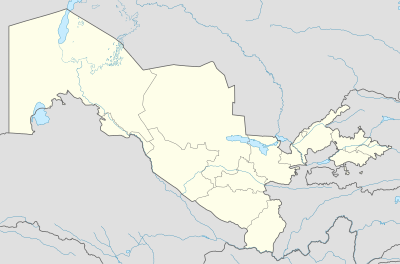
| Division | Capital City | Area (km2) |
Population (2022) |
Key |
|---|---|---|---|---|
| Andijan Region Uzbek: Андижон вилояти/Andijon Viloyati |
Andijan Andijon |
4,303 | 3,253,528 | 2 |
| Bukhara Region Uzbek: Бухоро вилояти/Buxoro Viloyati |
Bukhara Buxoro |
41,937 | 1,976,823 | 3 |
| Fergana Region Uzbek: Фарғона вилояти/Fargʻona Viloyati |
Fergana Fargʻona |
7,005 | 3,896,395 | 4 |
| Jizzakh Region Uzbek: Жиззах вилояти/Jizzax Viloyati |
Jizzakh Jizzax |
21,179 | 1,443,408 | 5 |
| Republic of Karakalpakstan Karakalpak: Қарақалпақстан Республикасы/Qaraqalpaqstan Respublikasiʻ Uzbek: Қорақалпоғистон Республикаси/Qoraqalpogʻiston Respublikasi |
Nukus No‘kis Nukus |
161,358 | 1,948,488 | 14 |
| Kashkadarya Region Uzbek: Қашқадарё вилояти/Qashqadaryo Viloyati |
Karshi Qarshi |
28,568 | 3,408,345 | 8 |
| Khorezm Region Uzbek: Хоразм вилояти/Xorazm Viloyati |
Urgench Urganch |
6,464 | 1,924,163 | 13 |
| Namangan Region Uzbek: Наманган вилояти/Namangan Viloyati |
Namangan Namangan |
7,181 | 2,931,056 | 6 |
| Navoiy Region Uzbek: Навоий вилояти/Navoiy Viloyati |
Navoiy Navoiy |
109,375 | 1,033,857 | 7 |
| Samarkand Region Uzbek: Самарқанд вилояти/Samarqand Viloyati |
Samarkand Samarqand |
16,773 | 4,031,324 | 9 |
| Surkhandarya Region Uzbek: Сурхондарё вилояти/Surxondaryo Viloyati |
Termez Termiz |
20,099 | 2,743,201 | 11 |
| Syrdarya Region Uzbek: Сирдарё вилояти/Sirdaryo Viloyati |
Gulistan Guliston |
4,276 | 878,591 | 10 |
| Tashkent City Uzbek:Тошкент/Toshkent Shahri |
Tashkent Toshkent |
327 | 2,860,595 | 1 |
| Tashkent Region Uzbek: Тошкент вилояти/Toshkent Viloyati |
Nurafshon Nurafshon |
15,258 | 2,941,522 | 12 |
The regions are further divided into districts (tuman).
Largest cities
|
Largest cities or towns in Uzbekistan
|
||
|---|---|---|
| Rank | Name | Pop. |
| 1 | Tashkent | 2,571,668 |
| 2 | Namangan | 678,200 |
| 3 | Samarkand | 573,200 |
| 4 | Andijan | 468,100 |
| 5 | Nukus | 310,000 |
| 6 | Fergana | 299,000 |
| 7 | Bukhara | 285,000 |
| 8 | Qarshi | 260,000 |
| 9 | Kokand | 260,000 |
| 10 | Margilan | 242,500 |
Economy
Uzbekistan mines 80 tons of gold annually, seventh in the world. Uzbekistan's copper deposits rank tenth in the world and its uranium deposits twelfth. The country's uranium production ranks seventh globally. The Uzbek national gas company, Uzbekneftegaz, ranks 11th in the world in natural gas production with an annual output of 60 to 70 billion cubic metres (2.1–2.5 trillion cubic feet). The country has significant untapped reserves of oil and gas: there are 194 deposits of hydrocarbons in Uzbekistan, including 98 condensate and natural gas deposits and 96 gas condensate deposits.
Uzbekistan has a GNI per capita of US$2,020 in current dollars in 2018, giving a PPP equivalent of US$7,230. In 2011, Uzbekistan was the world's seventh-largest producer and fifth-largest exporter of cotton as well as the seventh-largest world producer of gold. It is also a regionally significant producer of natural gas, coal, copper, oil, silver and uranium.
Agriculture employs 27% of Uzbekistan's labour force and contributes 17.4% of its GDP (2012 data). The country has a considerable production of carrots as well.
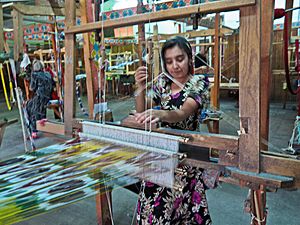
The government of Uzbekistan restricts foreign imports in many ways, including high import duties. Excise taxes are applied in a highly discriminatory manner to protect locally produced goods, although the excises taxes were removed for foreign cars in 2020.
Uzbekistan was ranked 82nd in the Global Innovation Index in 2023.
Demographics
| Population | |||
|---|---|---|---|
| Year | Million | ||
| 1950 | 6.2 | ||
| 2000 | 24.8 | ||
| 2018 | 32.5 | ||
| 2023 | 36.2 | ||
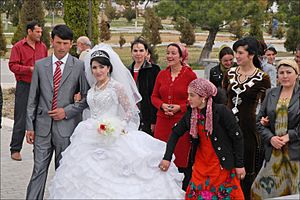
As of 2022, Uzbekistan has the largest population out of all the countries in Central Asia. Its 36 million citizens comprise nearly half the region's total population. The population of Uzbekistan is very young: 34.1% of its people are younger than 14 (2008 estimate). According to official sources, Uzbeks comprise a majority (84.5%) of the total population. Other ethnic groups include Russians 2.1%, Tajiks 4.8%, Kazakhs 2.4%, Karakalpaks 2.2% and Tatars 0.5% as of 2021.
Russians in Uzbekistan represented 5.5% of the total population in 1989.
At least 10% of Uzbekistan's labour force works abroad, mostly in Russia and Kazakhstan.
Life expectancy in Uzbekistan is 66 years among men and 72 years among women.
Religion
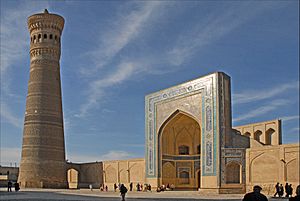
Uzbekistan is a secular country and Article 61 of its constitution states that religious organizations and associations shall be separated from the state and equal before law. The state shall not interfere in the activity of religious associations. Islam is the dominant religion in Uzbekistan.
Languages
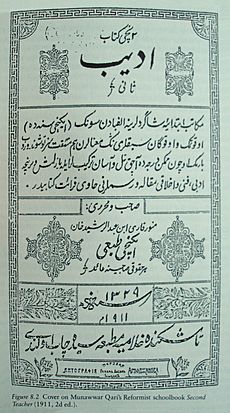
The Uzbek language is one of the Turkic languages. It is the only official national language and since 1992 is officially written in the Latin alphabet.
Although the Russian language is not an official language in the country, it is widely used in many fields as a second official de-facto language. Digital information from the government is bilingual. The country is also home to approximately one million native Russian speakers. Signs throughout the country are both in Uzbek and Russian.
The Tajik language (a variety of Persian) is widespread in the cities of Bukhara and Samarkand because of their relatively large population of ethnic Tajiks. It is also found in large pockets in Kasansay, Chust, Rishtan and Sokh in Ferghana Valley, as well as in Burchmulla, Ahangaran, Baghistan in the middle Syr Darya district, and finally in, Shahrisabz, Qarshi, Kitab and the river valleys of Kafiringan and Chaganian, forming altogether, approximately 10–15% of the population of Uzbekistan.
There are no language requirements to attain citizenship in Uzbekistan.
Music
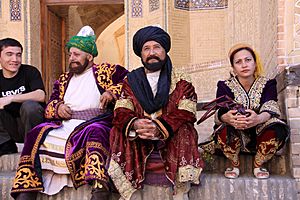
Central Asian classical music is called Shashmaqam, which arose in Bukhara in the late 16th century when that city was a regional capital. [1] Shashmaqam is closely related to Azerbaijani Mugam and Uyghur muqam. The name, which translates as six maqams refers to the structure of the music, which contains six sections in six different Musical modes, similar to classical Persian traditional music. Interludes of spoken Sufi poetry interrupt the music, typically beginning at a lower register and gradually ascending to a climax before calming back down to the beginning tone.
Education
Students attend school Monday through Saturday during the school year, and education officially concludes at the end of the 11th grade.
Several universities, including Westminster University, Turin University, Management University Institute of Singapore, Bucheon University in Tashkent, TEAM University and Inha University Tashkent maintain a campus in Tashkent offering English language courses across several disciplines. The Russian-language high education is provided by most national universities, including foreign Moscow State University and Gubkin Russian State University of Oil and Gas, maintaining campuses in Tashkent. As of 2019, Webster University, in partnership with the Ministry of Education, has opened a graduate school offering an MBA in Project Management and a MA in Teaching English as a Second Language (TESL).
There are three Islamic institutes and an academy in Uzbekistan. They are Tashkent islamic institute, Mir Arab high school, School of hadith knowledge, International islamic academy of Uzbekistan.
Cuisine

Uzbek cuisine is influenced by local agriculture; since there is a great deal of grain farming in Uzbekistan, bread and noodles are of importance and Uzbek cuisine has been characterised as "noodle-rich". Mutton is a popular variety of meat due to the abundance of sheep in the country and it is part of various Uzbek dishes.
Uzbekistan's signature dish is palov (or plov), a main course typically made with rice, meat, carrots, and onions, though it was not available to ordinary people until the 1930s. There are many regional variations of the dish. Often the fat found near the sheep tail, qurdiuq, is used. In the past, the cooking of palov was reserved for men, but the Soviets allowed women to cook it as well. Since then, it seems, the old gender roles have been restored.
Other notable national dishes include shurpa, a soup made of large pieces of fatty meat (usually mutton), and fresh vegetables; norin and laghman, noodle-based dishes that may be served as a soup or a main course; manti, chuchvara, and somsa, stuffed pockets of dough served as an appetizer or a main course; dimlama, a meat and vegetable stew; and various kebabs, usually served as a main course.
Green tea is the national hot beverage consumed throughout the day; teahouses (chaikhanas) are of cultural importance. Black tea is preferred in Tashkent, but both green and black teas are consumed daily, without milk or sugar. Tea always accompanies a meal, but it is also a drink of hospitality that is automatically offered: green or black to every guest. Ayran, a chilled yogurt drink, is popular in summer.
Sport
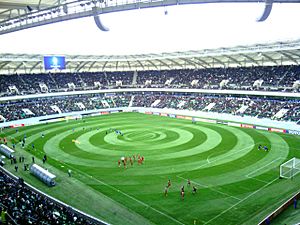
Uzbekistan is home to former racing cyclist Djamolidine Abdoujaparov. Abdoujaparov has won the green jersey points contest in the Tour de France three times. Abdoujaparov was a specialist at winning stages in tours or one-day races when the bunch or peloton would finish together. He would often 'sprint' in the final kilometer and had a reputation as being dangerous in these bunch sprints as he would weave from side to side. This reputation earned him the nickname 'The Terror of Tashkent'.
Artur Taymazov won Uzbekistan's inaugural wrestling medal at the 2000 Summer Olympics, followed by three Olympic gold medals in Men's 120 kg in 2004, 2008 and 2012. His 2008 gold was taken away in 2017 after a re-testing of samples from the Beijing Games and Taymazov was later stripped of his London 2012 Olympic gold medal after re-analysis of stored samples in 2019. His London gold had made him the most successful freestyle competitor in Olympic history. He is the 60th athlete to be disqualified from the London Olympics after the event.
Ruslan Chagaev is a former professional boxer representing Uzbekistan in the WBA. He won the WBA champion title in 2007 after defeating Nikolai Valuev. Chagaev defended his title twice before losing it to Vladimir Klitschko in 2009. Another young talented boxer Hasanboy Dusmatov, light flyweight champion at the 2016 Summer Olympics, won the Val Barker Trophy for the outstanding male boxer of Rio 2016 on 21 August 2016. On 21 December 2016 Dusmatov was honoured with the AIBA Boxer of the Year award at a 70-year anniversary event of AIBA.
Michael Kolganov, an Uzbek–born sprint canoer, was world champion and won an Olympic bronze in Sydney in the K1 500-meter in 2000 on behalf of Israel. In 2009 and 2011, another Uzbek émigré, gymnast Alexander Shatilov, won a world bronze medal as an artistic gymnast in floor exercise, though he lives in and represents Israel in international competitions. Oksana Chusovitina has attended eight Olympic games, and won five world medals in artistic gymnastics including an Olympic gold. Some of those medals were won while representing Germany and the Soviet Union, though she currently competes for Uzbekistan.
Uzbekistan is the home of the International Kurash Association. Kurash is an internationalised and modernised form of traditional Uzbek wrestling.
Football is the most popular sport in Uzbekistan. Uzbekistan's premier football league is the Uzbek Super League, which has consisted of 16 teams since 2015. The current champions (2022) are FC Pakhtakor. Pakhtakor holds the record for the most Uzbekistan champion titles, having won the league ten times. Uzbekistan's football clubs regularly participate in the AFC Champions League and the AFC Cup. FC Nasaf Qarashi won the AFC Cup in 2011, the first international club cup for Uzbek football.
Humo Tashkent, a professional ice hockey team was established in 2019 with the aim of joining Kontinental Hockey League (KHL), a top level Eurasian league in the future. Humo will join the second-tier Supreme Hockey League (VHL) for the 2019–20 season. Humo play their games at the Humo Ice Dome which cost over €175 million in construction; both the team and arena derive their name from the mythical Huma bird, a symbol of happiness and freedom. Uzbekistan Hockey Federation (UHF) began preparation for forming national ice hockey team in joining IIHF competitions.
Before Uzbekistan's independence in 1991, the country was part of the Soviet Union football, rugby union, basketball, ice hockey, and handball national teams. After independence, Uzbekistan created its own football, rugby union, basketball and futsal national teams.
Tennis is a very popular sport in Uzbekistan, especially after Uzbekistan's sovereignty in 1991. Uzbekistan has its own Tennis Federation called the "UTF" (Uzbekistan Tennis Federation), created in 2002. Uzbekistan also hosts an International WTA tennis tournament, the "Tashkent Open", held in Uzbekistan's capital city. This tournament has been held since 1999, and is played on outdoor hard courts. The most notable active players from Uzbekistan are Denis Istomin and Akgul Amanmuradova.
Chess is quite popular in Uzbekistan. The country boasts Rustam Kasimdzhanov, who was the FIDE World Chess Champion in 2004, and many junior players like Nodirbek Abdusattorov, the 2021 World Rapid Chess Champion. The Uzbek team – consisting of GM Nodirbek Abdusattorov, GM Nodirbek Yakubboev, GM Javokhir Sindarov, GM Shamsiddin Vokhidov and GM Jahongir Vakhidov won gold at the 44th Chess Olympiad in Chennai.
Other popular sports in Uzbekistan include basketball, judo, team handball, baseball, taekwondo, and futsal.
Ulugbek Rashitov, won the country's first Olympic gold medal in taekwondo, at the Summer Olympic Games in Tokyo 2021.
In 2022, the World Judo Championships were held in Tashkent.
In 2024, the FIFA Futsal World Cup will be held in Uzbekistan.
Interesting facts about Uzbekistan
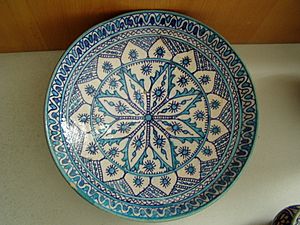
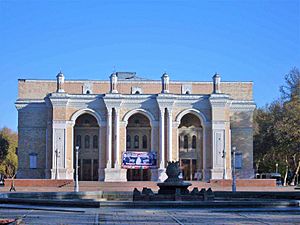
- Two major Uzbek cities, Bukhara and Samarkand, were once part of the Silk Route.
- Uzbekistan is a major producer and exporter of cotton.
- Uzbek cotton is even used to make banknotes in South Korea.
- Uzbekistan has a high literacy rate, with 99.9% of adults above the age of 15 being able to read and write.
- Uzbekistan is a secular state, with a presidential constitutional government in place.
- The country is predicted to be one of the fastest-growing economies in the world (top 26) in future decades, according to a survey by global bank HSBC.
See also
 In Spanish: Uzbekistán para niños
In Spanish: Uzbekistán para niños




